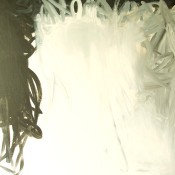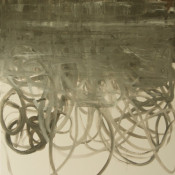Formation
-
acrylic on linen
48 x 36
-
acrylic on linen
36 x 48
-
acrylic on linen
48 x 36
-
acrylic on linen
48 x 36
-
acrylic on linen
40 x 30
-
acrylic on linen
40 x 30
-
acrylic on linen
48 x 36
-
acrylic on linen
48 x 36
-
acrylic on linen
48 x 36
-
acrylic on linen
48 x 36
-
acrylic on linen
48 x 36
-
acrylic on linen
48 x 36
-
acrylic on linen
40 x 30
-
acrylic on linen
48 x 36
-
acrylic on linen
48 x 36
-
acrylic on linen
48 x 36
-
acrylic on linen
48 x 36
-
acrylic on linen
36 x 48
-
acrylic on linen
40 x 30
-
acrylic on linen
40 x 35
-
acrylic on linen
40 x 35
-
acrylic on linen
48 x 36
-
acrylic on linen
40 x 30
-
acrylic on linen
48 x 36
-
acrylic on linen
48 x 36
Essay:
Formation, 2015
acrylic on linen
Landscape abstraction continues to be the primary focus of my artwork. My recent series, Formation, recalls the familiar geological landscape where I live in the Central United States. Arkansas is known for its landscape and natural beauty. To me, abstract painting allows me to visually dissect the landscape and provides an opportunity to communicate through sensory experiences. As my paintings take form, my relationship with the earth continues to evolve over time.
Northwest Arkansas is part of an expansive geological site referred to as the U. S. Interior Highlands situated between the Eastern Appalachians and the Western Rocky Mountains. Building railroads and highways across the United States required blasting through rock formations exposing geological cross sections creating greater access to rural areas once inhabited primarily by natives and my kinfolk.
The Formation Series is intended to pay homage to the geological landscape. Referencing a tonal color palette, I weave paint into layers, subtly shifting back and forth between surface and depth. It is a mapping process with neutral pigments as I spread paint across the surface directionally, to the north, south, east and west. I look beyond obvious beauty toward feeling a connection to the landscape for its powerful energy developing over billions of years and hosting countless life forms. I am reminded that what lies beneath supports what lives above.
From the water’s edge, trickling streams and creeks, lined with rocks and boulders, quenching the thirst of: flora and fauna, including ferns and fungi, as well as, native hardwoods: the Sugar Maple, Shag Bark Hickory and Black Walnut trees. I consider the idea that the human body and experience replicates the landscape topography’s peaks and valleys. I am also reminded that my body is a fragment within this landscape, existing for a delicate whisper in time.
And to the contrary:
“From my rotting body, flowers shall grow and I am in them and that is eternity.”
—Edvard Munch


























